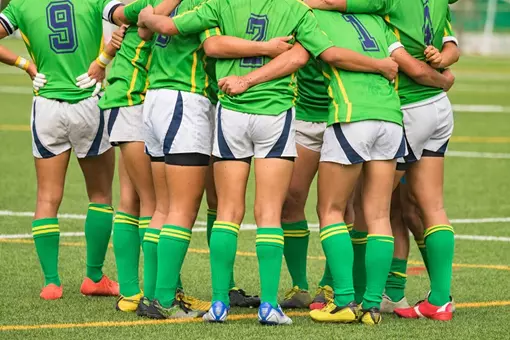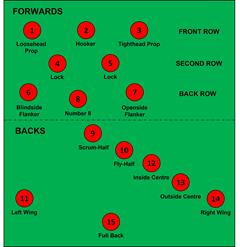What are the positions in a Rugby Union team?

Rugby Union is one of the most popular sports in the world, played in both southern and northern hemisphere, but what are the positions across the team and their role in the team?
In a Rugby Union team, there are 15 players on the pitch, each with a different role within the team. Some coaches or players refer to their position by their shirt number, and some refer to the role name. Either way, knowing what each of them mean and how they work within the team is critical to having a cohesive team. The easiest way of splitting the positions is between Forwards and Backs. We will take you through the positions by numbers and their roles within the team moving up through the team.
For rugby training accessories, such as tackle pads and shields, check out our range available here online at Davies Sports by clicking the link.
FORWARDS

1 & 3 – Props: Loosehead & Tighthead
The Props along with the hooker make up what is known as the front row. This is in reference to their rugby position in the scrum. The loosehead prop will be on the left head will be on the outside of the scrum. The tighthead will be on right of the hooker with their head in the mix at a scrum. In team lineouts, props should be able to support or lift the jumper to try securing the ball for the team.
Away from set pieces, both props help to secure the ball when a player has been tackled due to their strength. When in attack, they are used as battering rams, receiving short passes and hitting the opposition at pace to help drive the team forward and open the game for the Backs. To be successful at either prop position players must be extremely strong in the neck, shoulders, upper body and legs, and they should relish head-to-head competition.
2 – Hooker
Lining up in the scrum completing the front row between the two props is the hooker. This is the main decision maker within the forwards. The hooker is responsible for coordinating the timing at the scrum, and also trying to win possession in the scrummage by hooking the ball back through the props’ legs.
Another key role for a hooker is at the lineout where they will throw the ball in and hit the lineout jumper is expecting the ball accurately. They will also take control of the lineouts determining where the ball will be thrown. In open play the hooker plays a similar role to the props, securing possession at rucks and mauls, or taking short ‘crash passes.’
4 & 5 – Locks / Second Row
The second row forwards are the locks, and are names so as they form the second row behind the front row, and lock the scrum together. They are the engine room of the scrum, providing the main source of power, meaning they must have excellent scrummage technique and power in both shoulders and legs. They also have a big role in the line outs as they will be the target. This means they need to be tall but also agile in jumping.
In open play, the second row’s duties have evolved from being support players at rucks and mauls, to ball carriers when in attack. These players often do open up opposition defences with their power and strength.
6 & 7 – Flanker: Blind-Side & Open-Side
Flankers are often the players with the fewest set responsibilities, however because of this they do get given a variety of tasks, meaning they must be excellent all-rounders with inexhaustible energy. Speed, strength, fitness, tackling and handling skills are all vital for the flankers.
Both flankers will tend to be the most involved in the game due to the variety of skills they possess. Flankers will go from winning balls at the ruck and maul, to collecting short passes from tackled players and making their own big tackles in open play. While they can rarely be blamed for a loss, they can certainly be the key to victory.
The open-side flanker plays on the far side of the scrum from the touchline and is often smaller in size than their blind-side partner as they need to be a little more mobile. The blind-side flanker tends to have bigger, more physical role.
8 – Number 8
The number 8 is similar to the two flankers, who together they trio make up the back row. In a scrum, the number 8 binds the team at the back of the scum. This is important because the number 8 can drive the team forward and get them over the gain line.
An important role the number 8 has in a scrum is it is the only Forward who are allowed to pick the ball up from the base of the scrum. Supporting the play, tackling and ball-carrying the gain vital yardage are the Number 8’s areas of expertise, making them an explosive, dynamic runner.
BACKS
9 – Scrum-Half
The scrum-half is the player that links the Forwards to the Backs, and is a key player in building attacks. The scrum-half will play just behind the forwards and control when the ball is moved from the scrum, mauls or rucks out to the Backs.
The key attributes for the scum-half are good vision, speed and awareness to make those quick decisions and lightning reactions. They do tend to be one of the smaller players on the pitch and so rely on protection from their own forwards. As the scrum-half’s most important job is to control both attack and defense, it is really important that they are the best passer on the team.
10 – Fly-Half
The heartbeat of the side and is often referred to the most important player on the pitch. This is because the fly-half runs every attack, organises the defence and will decide when to kick to relieve the pressure. In attack, they take responsibility on deciding when the ball is passed out from the forward to the centres and setting up the attack, finding the gaps in the defence.
In defence, they will marshal the backs to ensure each opposition player is covered, and need to be strong at tackling to snuff out opposition attacks before they start. The fly-half will also be one of the best kickers on the team, and is generally the designated kicker for conversions, penalties and drop goal attempts.
11 & 14 – Wing
The wingers are the two players that will be on the outermost part of the pitch. The wingers will generally be the try scorers in attack, and the last line of defence with the opposition getting the ball out wide to score. The wingers will be the fastest players on the team and will need the endurance to get up and down the pitch in a match. Athleticism and agility are also very important for a winger.
12 & 13 – Centre: Inside & Outside
The centres are the two players right behind the fly-half in the Backs. The inside centre is the one clsoest to the fly half with the outside centre next in line. The main role of the centres is to take on their opposite number in an attempt to either break the defensive line, or draw in enough of the opposing defenders to create space and opportunities for their team-mates to score a try. As such they need to be strong and powerful, and when attack turns into defence, they must also be accomplished at tackling.
The inside centre is often more creative and versatile as they are expected to pass and kick the ball as well as the fly-half. The outside centre tends to run the direct lines and so will be strong, dynamic runners with a good eye for exposing gaps in the opposition defence.
15 – Full Back
The full-back is the last player within the backs and is often referred to as the “sweeper” when in defence. They will help dictate to their team in defence where they need to be as they can see the full pitch. They have to position themselves in the right place to receive kicks from the opposing team, and so full-backs have to have the best ball handling skills on the team.
This is a high-pressure rugby position as the role combines tackling as the last player if the opposing team break through the defence, catching the high balls, passing out quickly to start attacks, and being able to kick the help progress the team up the pitch.
The great part about Rugby Union is there is a position available for all types of players. Each player is as important to the team as the other, and working the roles together in a team is the key to victory. So now you have seen the rugby positions along with the rugby numbers, what position should you play? Or what position is best suited for the players you coach?




